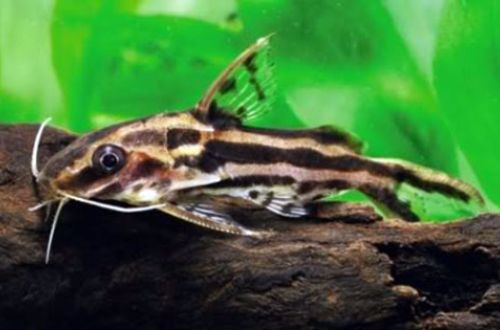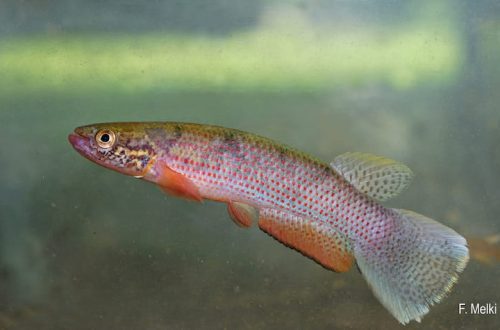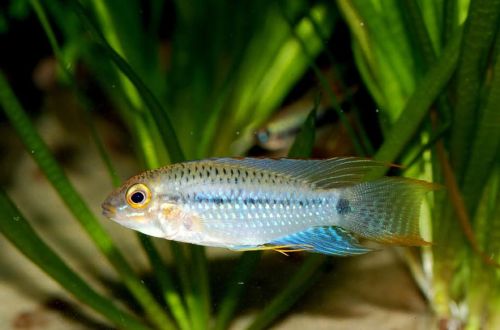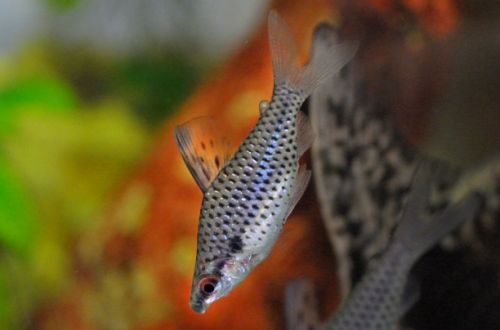
Striped Synodontis
Striped Synodontis or Orange Squeaker Catfish, scientific name Synodontis flavitaeniatus, belongs to the Mochokidae family. A great addition to the general aquarium – unpretentious, friendly, adapts to various water conditions, making it compatible with most aquarium fish.

Contents
Habitat
In nature, it is found exclusively in Lake Malebo (Eng. Pool Malebo), located along the Congo River (Africa). On both sides of the lake are the two capitals of Brazzaville (Republic of the Congo) and Kinshasa (Democratic Republic of the Congo). Currently, the reservoir is experiencing a strong negative impact of human activities, more than 2 million people live along the banks in total.
Brief information:
- The volume of the aquarium – from 80 liters.
- Temperature – 23-28°C
- Value pH — 6.5–8.0
- Water hardness – soft to hard (3-25 dGH)
- Substrate type – sandy, soft
- Lighting – subdued or moderate
- Brackish water – no
- Water movement – light or moderate
- The size of the fish is up to 20 cm.
- Nutrition – any drowning
- Temperament – peaceful
- Keeping alone or in a group in the presence of shelters
Description
Adults reach a length of about 20 cm. The body pattern consists of horizontal wide yellow stripes and extensive spots and stripes of a brownish tint. The colors of catfish may differ in a darker or lighter direction. Sexual dimorphism is weakly expressed, it is rather problematic to distinguish a male from a female.
Food
The diet of the Striped Synodontis includes almost all types of popular foods (dry, frozen and live) in combination with herbal supplements in the form of peeled peas, cucumber. The food must be sinking.
Maintenance and care, arrangement of the aquarium
The optimal volume of the tank for one fish will start from 80 liters. The design uses a soft substrate with shelters formed by fragments of rocks, large stones, snags. The level of illumination is subdued, floating plants can act as an additional means of shading. The rest of the vegetation is at the discretion of the aquarist.
Water parameters have wide tolerances for pH and dGH. Water should be clean with a minimum level of contamination. To do this, along with the installation of an effective filtration system, it is necessary to regularly clean the soil from organic waste and replace part of the water (15–20% of the volume) with fresh water.
Behavior and Compatibility
Thanks to its adaptability to various water conditions and peaceful disposition, the Striped Synodontis pairs well with most other species, as long as they are not aggressive or overly active. It is worth noting that very small fish (less than 4 cm) should not be added, they can be accidentally eaten by an adult catfish. This is not a sign of predation, but a common behavioral reflex of most catfish – to eat everything that fits in the mouth.
It can get along with its relatives in the presence of a sufficient number of shelters, otherwise skirmishes over the territory may occur.
Reproduction / breeding
Not bred in home aquaria. Supplied for sale from commercial fish farms. Previously, it was mainly caught from the wild, but recently such specimens have not been found.
Fish diseases
The main cause of most diseases is unsuitable living conditions and poor-quality food. If the first symptoms are detected, you should check the water parameters and the presence of high concentrations of hazardous substances (ammonia, nitrites, nitrates, etc.), if necessary, bring the indicators back to normal and only then proceed with treatment. Read more about symptoms and treatments in the Aquarium Fish Diseases section.





